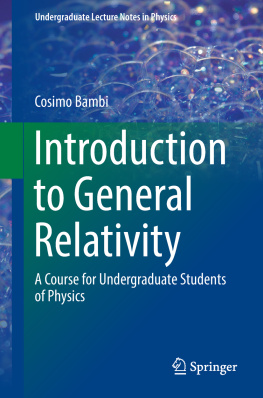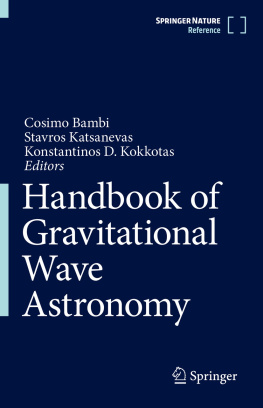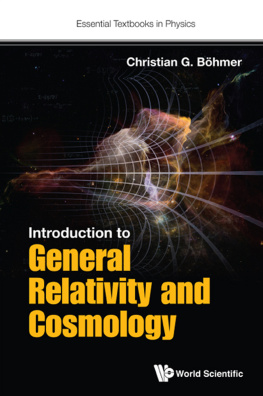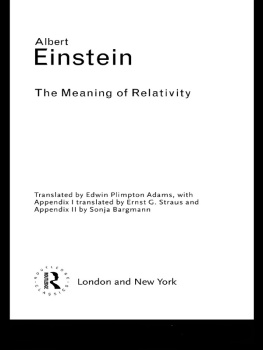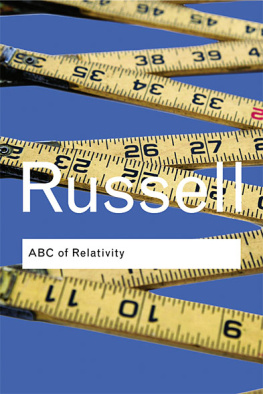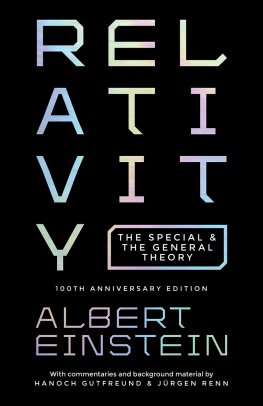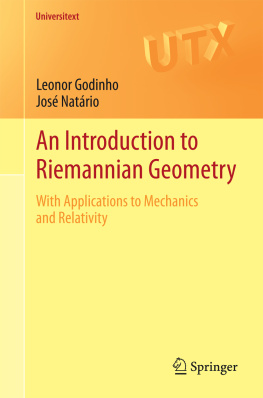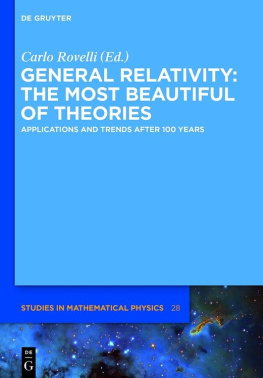Cosimo Bambi - Introduction to General Relativity
Here you can read online Cosimo Bambi - Introduction to General Relativity full text of the book (entire story) in english for free. Download pdf and epub, get meaning, cover and reviews about this ebook. year: 0, publisher: Springer Singapore, genre: Children. Description of the work, (preface) as well as reviews are available. Best literature library LitArk.com created for fans of good reading and offers a wide selection of genres:
Romance novel
Science fiction
Adventure
Detective
Science
History
Home and family
Prose
Art
Politics
Computer
Non-fiction
Religion
Business
Children
Humor
Choose a favorite category and find really read worthwhile books. Enjoy immersion in the world of imagination, feel the emotions of the characters or learn something new for yourself, make an fascinating discovery.
- Book:Introduction to General Relativity
- Author:
- Publisher:Springer Singapore
- Genre:
- Year:0
- Rating:3 / 5
- Favourites:Add to favourites
- Your mark:
- 60
- 1
- 2
- 3
- 4
- 5
Introduction to General Relativity: summary, description and annotation
We offer to read an annotation, description, summary or preface (depends on what the author of the book "Introduction to General Relativity" wrote himself). If you haven't found the necessary information about the book — write in the comments, we will try to find it.
Introduction to General Relativity — read online for free the complete book (whole text) full work
Below is the text of the book, divided by pages. System saving the place of the last page read, allows you to conveniently read the book "Introduction to General Relativity" online for free, without having to search again every time where you left off. Put a bookmark, and you can go to the page where you finished reading at any time.
Font size:
Interval:
Bookmark:
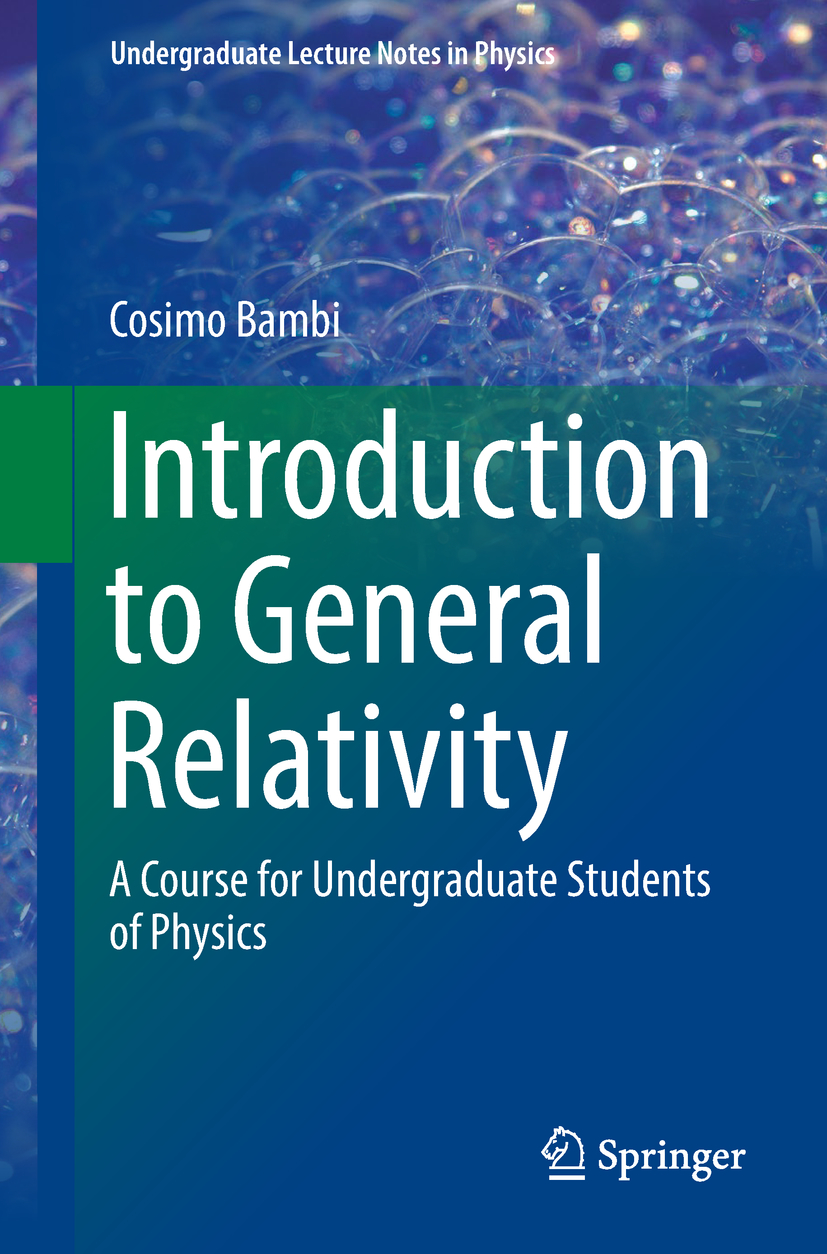
Undergraduate Lecture Notes in Physics (ULNP) publishes authoritative texts covering topics throughout pure and applied physics. Each title in the series is suitable as a basis for undergraduate instruction, typically containing practice problems, worked examples, chapter summaries, and suggestions for further reading.
An exceptionally clear and concise treatment of a standard undergraduate subject.
A solid undergraduate-level introduction to a graduate, advanced, or non-standard subject.
A novel perspective or an unusual approach to teaching a subject.
ULNP especially encourages new, original, and idiosyncratic approaches to physics teaching at the undergraduate level.
The purpose of ULNP is to provide intriguing, absorbing books that will continue to be the readers preferred reference throughout their academic career.
Series editors
Neil Ashby
University of Colorado, Boulder, CO, USA
William Brantley
Department of Physics, Furman University, Greenville, SC, USA
Matthew Deady
Physics Program, Bard College, Annandale-on-Hudson, NY, USA
Michael Fowler
Department of Physics, University of Virginia, Charlottesville, VA, USA
Morten Hjorth-Jensen
Department of Physics, University of Oslo, Oslo, Norway
Michael Inglis
Department of Physical Sciences, SUNY Suffolk County Community College, Selden, NY, USA
More information about this series at http://www.springer.com/series/8917

This Springer imprint is published by the registered company Springer Nature Singapore Pte Ltd. part of Springer Nature
The registered company address is: 152 Beach Road, #21-01/04 Gateway East, Singapore 189721, Singapore
The formulations of the theories of special and general relativity and of the theory of quantum mechanics in the first decades of the twentieth century are a fundamental milestone in science, not only for their profound implications in physics but also for the research methodology. In the same way, the courses of special and general relativity and of quantum mechanics represent an important milestone for every student of physics. These courses introduce a different approach to investigate physical phenomena, and students need some time to digest such a radical change.
In Newtonian mechanics and in Maxwells theory of electrodynamics, the approach is quite empirical and natural. First, we infer a few fundamental laws from observations (e.g., Newtons Laws) and then we construct the whole theory (e.g., Newtonian mechanics). In modern physics, starting from special and general relativity and quantum mechanics, this approach may not be always possible. Observations and formulation of the theory may change order. This is because we may not have direct access to the basic laws governing a certain physical phenomenon. In such a case, we can formulate a number of theories, or we can introduce a number of ansatzes to explain a specific physical phenomenon within a certain theory if we already have the theory, and then we compare the predictions of the different solutions to check which one, if any, is consistent with observations.
For example, Newtons First, Second, and Third Laws can be directly inferred from experiments. Einsteins equations are instead obtained by imposing some reasonable requirements and they are then confirmed by comparing their predictions with the results of experiments. In modern physics, it is common that theorists develop theoretical models on the basis of guesses (motivated by theoretical arguments but without any experimental support), with the hope that it is possible to find predictions that can later be tested by experiments.
At the beginning, a student may be disappointed by this new approach and may not understand the introduction of ad hoc assumptions. In part, this is because we are condensing in a course the efforts of many physicists and many experiments, without discussing all the unsuccessfulbut nevertheless necessary and importantattempts that eventually led to a theory in its final form. Moreover, different students may have different backgrounds, not only because they are students of different disciplines (e.g., theoretical physics, experimental physics, astrophysics, and mathematical physics) but also because undergraduate programs in different countries can be very different. Additionally, some textbooks may follow approaches appreciated by some students and not by others, who may instead prefer different textbooks. This point is quite important when we study for the first time the theories of special and general relativity and the theory of quantum mechanics, because there are some concepts that at the beginning are difficult to understand, and a different approach may make it easier or harder.
In the present textbook, the theories of special and general relativity are introduced with the help of the Lagrangian formalism. This is the approach employed in the famous textbook by Landau and Lifshitz. Here, we have tried to have a book more accessible to a larger number of students, starting from a short review of Newtonian mechanics, reducing the mathematics, presenting all the steps of most calculations, and considering some (hopefully illuminating) examples. The present textbook dedicates quite a lot of space to the astrophysical applications, discussing Solar System tests, black holes, cosmological models, and gravitational waves at a level adequate for an introductory course of general relativity. These lines of research have become very active in the past couple of decades and have attracted an increasing number of students. In the last chapter, students can get a quick overview of the problems of Einsteins gravity and current lines of research in theoretical physics.
Font size:
Interval:
Bookmark:
Similar books «Introduction to General Relativity»
Look at similar books to Introduction to General Relativity. We have selected literature similar in name and meaning in the hope of providing readers with more options to find new, interesting, not yet read works.
Discussion, reviews of the book Introduction to General Relativity and just readers' own opinions. Leave your comments, write what you think about the work, its meaning or the main characters. Specify what exactly you liked and what you didn't like, and why you think so.

